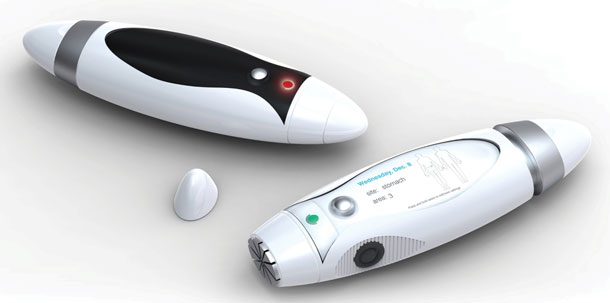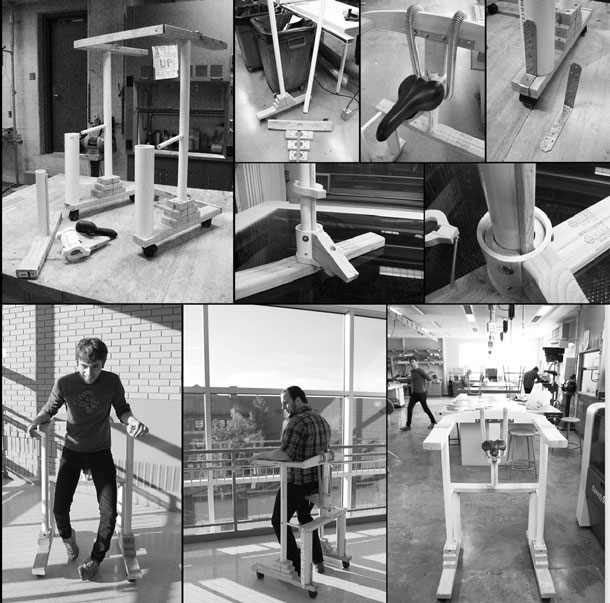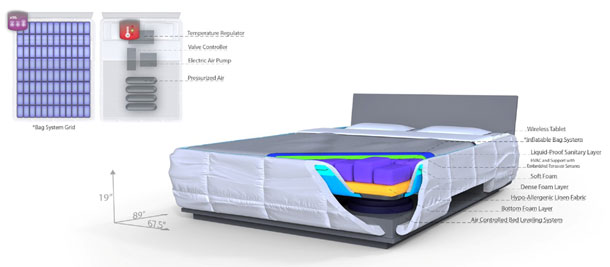We all have somebody near us—relatives, friends, sometimes even ourselves—struggling with chronic conditions such as arthritis or diabetes. As long-lasting conditions that can be controlled but not cured, chronic diseases affect the everyday living quality of a large portion of populations worldwide. According to the Centers for Disease Control and Prevention, chronic disease is the leading cause of death and disability in the United States. It accounts for 70 percent of all deaths in the U.S., which adds up to 1.7 million each year. As a nation, 75 percent of our healthcare dollars goes to the treatment of chronic diseases. Even though so much has been invested, patients still suffer from the effects of these conditions.
Creative Design for Healthcare Realities
In the fall of 2010, GE Healthcare challenged the creative industrial design students at Purdue University to explore new ways of improving the health self-management and living experience of patients with chronic conditions such as multiple sclerosis, cerebral palsy, Parkinson’s disease, and arthritis. The students were drawn from a senior Industrial Design (ID) course and a graduate Interaction Design (IXD) course. Four groups focused on investigating an individual chronic disease. Once this research was completed, each group divided into two teams to work on two separate design ideas for this disease. In each team, ID students led the design and IXD students created the interaction design components and ran iterative formative evaluations to advise the design.
These young designers explored the unknown in their search for these answers: What causes these diseases? What are the types and symptoms? What are the available treatments, and is it possible to monitor the development? The projects started by groups contacting family and friends who had been diagnosed with these diseases, visiting hospitals and clinics, and then searching for summative medical reports, white papers, and previous patient surveys. This information helped the students form a basic understanding of these health conditions and awareness of some potential problems. More importantly, they were able to communicate directly with some real patients and their caregivers. They realized that individual cases can be significantly different, and monitoring to control some conditions is extremely difficult with the existing medical technologies.
Imagining what a painful chronic condition feels like or the challenges of using a wheelchair in everyday life was difficult for the students, young men and women in their early 20s. The foundation of empathic design is feeling, with the goal of identifying difficulties that are hard to describe or envision. Emphasizing the user-centered perspective, we encouraged the students to conduct small-scale empathic studies that allowed them to build in-depth awareness of user needs in less-interrupted situations. The inescapable consistent pain patients endure amazed them. They were also emotionally affected by the challenges those with these diseases must endure and overcome in everyday life.
After understanding the diseases rationally and experiencing the conditions, the students realized that the challenges were far more complicated and difficult than they expected. But they also found possibilities for how patients’ living conditions can be improved. The students sketched and discussed many ideas through group brainstorming, peer review, and finally, selection by GE corporate reviewers. The group of students then built semi-functional physical mock-ups to further explore and test the features.
Ally: a medicine injector for multiple sclerosis patients
Multiple sclerosis (MS) is a disease with symptoms affecting both cognitive capability and physical movement. The patient’s disability develops from normal muscle weakness to the severe incapability to control vision, mouth, throat, bowels, urinary tract, and even mood. With current research and therapy, the disease can be treated to slow development, but unfortunately, it cannot be cured. Students conducted some emphatic studies to carry on normal life with blurred vision (by smearing a thin layer of Vaseline on a pair of eyeglasses) and numbed fingers (by soaking hands in icy cold water). They were shocked by being unable to perform quickly and alertly as they normally did and started to feel concern that things would become progressively worse at an unpredictable pace.
To slow down development of the disease, patients can take treatment through injections. One interviewee, a 22-year-old woman, gets Betaseron shots every other day. A total of twenty-one common injection sites were used to manage the injections: upper thighs, stomach, next to the naval, and areas in the lower back, and the back of the arms. The patient uses a calendar to keep track of rotating her sites to avoid irritation, and it is considered crucial for her well being. However, unfortunate misrecordings have taken place many times (See Figure 1). By using a paper calendar, mistakes are sometimes unavoidable. Things would be even worse if the patient were to lose it.

To solve this frustrating injection management issue, Ally reminds an MS patient of the time and location of the next injection. The project started with twelve different design ideas which were sketched and refined in discussion with the GE Healthcare professionals. Two ideas were selected and combined for further design. Students used whatever was convenient and at hand—markers, tape, and a paper box—to create physical mock-ups to test and explore the design (See Figure 2). In the final design the injection device includes an LED screen display for the injection interface. The black button on the side initiates injection, and the silver button on the front works as the select button on the interface.

Ally is not only an injector of medication but also, a cognitive support device that records the injection history and reminds the user of the correct time and location for the next injection. The data can be transferred and stored in computers through a wireless connection, so this crucial information can never be lost.

The design ran through a round of heuristic evaluations and was inspected based on visibility-of-system status, reduction in cognitive load, affordance, and constraint. For example, after one injection the system will lock to avoid an accidental dosage. The user is able to override such a lock, but with extra caution. The shape design of the injection button was carefully considered to enhance the affordance when the injector was pointed at a difficult site on the patient’s body
Agilis: an upright walker designed for cerebral palsy
Cerebral palsy (CP) refers to several neurological disorders that appear in early childhood and permanently affect body movement and muscle coordination. Although CP has no cure, early treatments and therapies will improve a patient’s capabilities. CP is generally in one of three types, but has many different symptoms because different parts of brain damage lead to different body disabilities. Designs to support CP patients must be equally diverse.
Among the most common CP disabilities is the inability to walk. Some with mild conditions can walk by themselves with supporting devices; others must use wheelchairs. In the emphatic studies, one student tied his knees together with layers of duck taps and shopped in Wal-Mart to experience the feeling of being physically handicapped in a highly populated public area. “When I was in the electronic wheelchair shopping at Wal-Mart, many people politely gave me room to pass, but few people looked into my eyes. I was surprised that I could feel so lonely in a busy supermarket.”
The team decided to tackle the problem through supporting a patient in an upright position allowing them eye-level social contact with the surroundings. Wheelchairs and walkers are designed for different needs. For example, some people who walk with a reverse device have improved posture and hip extension. When balance is a concern, a posterior walker can sometimes help, since the person’s center of mass is within the base of the walker’s support. For long-distance travel, a wheelchair is needed.
Based on the concept of combining a posterior walker and a wheelchair, students worked on a functional mock-up made of wood to test the possibilities. They built a mock-up (see Figure 4) with normal construction wood, pipes, and a bicycle seat. Bulky as it is, they can use it both to walk with and to sit in for resting. By switching the height and depth of the bicycle seat, both positions are comfortable enough for long periods of use.

The interaction design team-member evaluated the mock-up from different aspects and found two major problems, which were solved by improving the design:
- There was no protection on the armrests to prevent the patient from falling forward, so a control handlebar was added to an armrest, allowing the user to switch between walking and sitting positions
- The small wheels may not capably support the person’s weight and will be hard to rotate. Michelin’s Tweel technology was incorporated to enhance the durability and flexibility of wheels.

Therasleep: an intelligent bed that adjusts sleeping positions
CP appears in infancy or early childhood. Through interviews with several CP patients and their caregivers (usually the parents), students found an important issue that was usually ignored. Everybody, other than newborns, adjusts sleeping positions freely and unconsciously. But young CP patients are unable to change these positions freely. When awakened by uncomfortable (even harmful) positions, they will cry for help. As their caregivers, parents often have to get up in the night to change their child’s sleeping positions. Even without simulating the experience, students could quickly realize that this becomes exhausting over the long run. Motivated by this finding, students started to design an “intelligent” bed.

The mock-up bed (see Figure 6) was assembled from rows of inflatable bags. Each bag can be pumped separately, making it possible to adjust the sleeping position. A student slept on this mock-up for a full night to make sure the concept was both applicable and comfortable.

The final design, named the Therasleep bed (see Figure 7), is an enhanced version based on the mock-up. The bed contains a matrix system of strong inflatable bags. This bed detects and records positions of the sleeper. If an improper position has been maintained for too long, the bed will start to inflate some bags and deflate others, tilting the bed’s surface to adjust the sleeper’s position. Because everything happens during the deep-sleeping period, the patient will not be awakened, and the caregiver can also enjoy a good rest throughout the night.
Other projects
With the recommendation of GE Healthcare, all of our eight design projects were submitted to the 2011 International Design Excellence Awards (IDEA) competition, and three were selected as the finalists.

Other student projects (see Figure 8), all with similar research, design, prototyping, and evaluation approaches, included:
- The Mbuni Walker provides mobility and stability for patients with Parkinson’s disease.
- Motivate-Me detects, records, and motivates the patients to do more physical exercises,
- Euclidean attracts and encourages finger exercises from arthritis patients.
Empathic Research Makes the Difference
From the teaching and observations in our program, I realized that literature reviews, interviews, and examinations are not sufficient for a young healthy designer to really understand the needs and feelings of a patient suffering from a chronic condition. Yet, empathic study is essential to realize, feel, and face the challenges. It is not only about the empathy, but also, and perhaps more importantly, about being aware of the detailed issues the target audience faces both sensationally and emotionally. Physical mock-ups help the students analyze their solutions from a practical perspective and identify what will really work and what will not. Formative user experience evaluation methods are essential. The potential users, design experts, and even the designer all should act as evaluators to access and improve the designs.
Some problems are solvable, but others may not have solutions in design. Students felt helpless in many cases, but they also realized that for some patients with chronic conditions, improving their living quality is so very vital that even slight improvements will mean a lot to their lives.慢性疾病影响着全球众多人的生活。一群工业设计学生勇于接受挑战,寻找方法改善多发性硬化症、大脑性麻痹、帕金森氏症和关节炎患者的健康和生活条件。这些年轻的设计师在寻找创新解决方案的过程中不断探索未知领域,发现了同理心研究的重要性,同理心帮助他们理解、感受和面对遭受此类疾病折磨的患者的病痛。文章全文为英文版
만성 질환은 세계적으로 많은 사람들의 삶에 영향을 미치고 있습니다. 한 그룹의 산업디자인 학도들에게 다발성 경화증, 뇌성마비, 파킨슨병, 관절염이 있는 환자들의 건강 및 생활여건을 개선할 방법을 탐구하라는 과제를 주었습니다. 이들 젊은 디자이너들은 혁신적 솔루션을 찾는 탐색에서 미지의 것들을 탐구하였고, 공감적 연구가 그런 질병을 앓고 있는 환자들의 어려움을 파악하고, 느끼고 직면하는 데 중요하다는 것을 알았습니다. 전체 기사는 영어로만 제공됩니다.
As doenças crônicas afetam a vida de grande parte da população no mundo todo. Um grupo de estudantes de desenho industrial foi convidado a explorar formas para melhorar as condições de saúde e de vida de pacientes com esclerose múltipla, paralisia cerebral, doença de Parkinson e artrite. Esses jovens designers exploraram o desconhecido, buscando soluções inovadoras, e aprenderam a importância do estudo empático para ajudá-los a compreender, sentir e enfrentar os desafios de pacientes que sofrem dessas doenças. O artigo completo está disponível somente em inglês.
今日、世界中の多くの人々が慢性病と共に生活している。工業デザインを学ぶ学生のグループに、多発性硬化症、脳性まひ、パーキンソン病、および関節炎を患う患者の健康と生活を向上する方法を研究するという課題が出された。若いデザイナーたちは、革新的ソリューションを求めて未知の分野を研究することになった。その結果、このような症状を患う患者の困難を理解し、感じ、患者が直面する困難を知るには、共感的な研究が重要であることを学んだ。原文は英語だけになります
Las afecciones crónicas afectan la vida de una gran parte de las poblaciones a nivel mundial. A un grupo de estudiantes de Diseño Industrial se le encargó el desafío de explorar maneras de mejorar la salud y las condiciones de vida de pacientes con esclerosis múltiple, parálisis cerebral, enfermedad de Parkinson y artritis. Estos jóvenes diseñadores exploraron lo desconocido en su investigación en busca de soluciones innovadoras y aprendieron la importancia de los estudios empáticos para ayudarlos a comprender, sentir y enfrentar los desafíos de los pacientes que sufren estas afecciones. La versión completa de este artículo está sólo disponible en inglés
